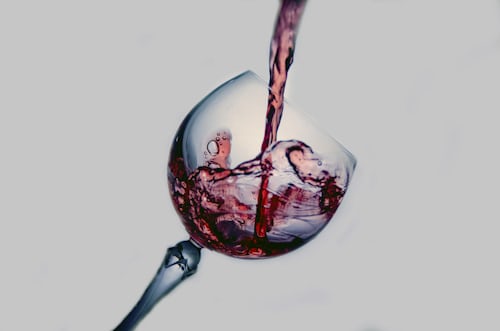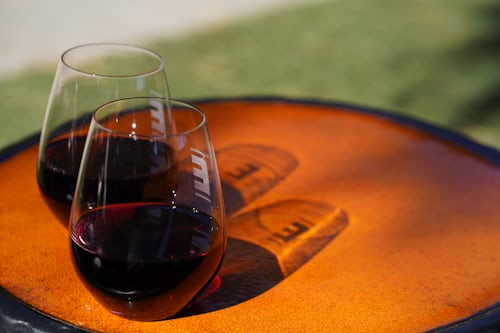Winemaking is a complicated process, but it can easily be mastered if you have time and desire. It is possible to make homemade wine only with the right ingredients, equipment, and, most importantly, patience to see the finish. In this article, I will guide you through a safe and reliable way to make fresh and healthy wine from supermarket grape juice. No special equipment, chemicals, or artificial additives are used in the recipe provided. Learn how to make wine from grape juice at home!
How To Make Wine From Grape Juice At Home

Wine is made at home by adding yeast to a blend of sugar, fruit juice, or even fresh fruit. By fermenting the sugar, the yeast digests it and releases two by-products of the chemical reaction.
Alcohol, the main component in winemaking, is the first by-product. The second carbon dioxide is produced in smaller quantities and can be considered physically as bubbles emitting from the top of the mixture of fermentation.
Homemade wine is produced without oxygen, also known as an anaerobic environment. The absence of oxygen allows the yeast to thrive and digest the fermentation’s fluid sugars, thereby increasing the alcohol content. However, this increase in alcohol harms the yeast. Once all the sugars have been consumed, the yeast dies because the amount of alcohol increases.
How To Make Wine From Grape Juice At Home: Juice Concentrate

Here’s how to make wine from grape juice at home! Homemade wine may be made from a number of sugar-containing ingredients. Fresh fruits such as grapes, blueberries, and strawberries are all good ingredients for the production of household wine. Apples as a sugar source will lead to a slightly fermented cider.
The use of grape juice concentrate such as Welch’s grape juice, which results in Welch’s wine, is also an ideal ingredient for making homemade wine. Concentrate grape juice is produced for a period of time by slowly stirring fresh grapes in hot water. The grapes are then strained from the liquid, leading to a grape jus concentrate rich in flavor. The production of wine from concentrate grape juice results in a homemade wine that is perfect for daily use as a table wine.
Your grape juice should not be stored in the fridge at room temperature. When you put your grape juice in the fridge, ensure that it is taken out and returned to room temperature before the winemaking process continues.
Drink or take away 5 liters of water. Most people want to do that in a few days. There is no reason to rinse it out when the bottle is empty. It’s clean because it was packed with potable water, remember?
Add the yeast and warm the juice.
Pour about half your first grape juice cardboard into the empty 5-liter bottle. Add one teaspoonful of wine yeast, place the top of the bottle, and bug it. This is the correct technical term used by winemakers around the world for this process, although a small number still calls it aeration.
Leave the 5-liter bottle warm and take off the rest of the day. Yeast is a living body. Its comfort zone is very similar to ours. Think of the temperature of the short sleeve. You don’t have to keep it in the dark, but it will spoil direct sunlight.
Prepare sugar syrup.
You will notice that the 5-liter bottle has begun to bubble. Add the other half cardboard and whole cardboard of the first juice, so that the 5-liter cardboard is now a little under half full. Then tighten the bottle cap and then return it half a turnoff. This is extremely important. Fermentation produces a lot of emission of carbon dioxide gas. Take a 2-liter bottle of coke and do with the contents whatever you like.
Pour into the empty coke bottle 500 grams (18 ounces) of sugar. This is made much easier by a plastic funnel. Pour boiled tap water or drinking water on sugar until half full (1 liter or 2 pints) in the bottle. Shake it to dissolve all sugar. Don’t add it yet to the wine.

Combine all parts.
The wine should now ferment well. Add another 5-liter bottle of grape juice and all the sugar syrup. The amount of liquid should still be under the bottle’s shoulder. Turn the bottle into the sugar syrup to mix. Tighten the cap of the bottle and, as before, turn it off half a turn. This is for today. This is for today. Also, one card of grape juice should still be unopened.
Monitor your wine.
By day ten or so, the lively fermentation should have eased so that the last carton of juice can be added safely. Fill the 5-liter bottle to the bottom of the neck. Do the same drill with the bottle cap, as previously mentioned. Now, you’ve just got to wait. Check the bottle cap and watch bubbling every day, showing signs of completion. It usually takes two or three weeks to complete the wine.
Chill the wine, bottle, and enjoy!
If the bubbling has stopped (or at least slowed to sometimes bubble) in your five-liter bottle, put the bottle in your fridge (not the freezer!) for about three days. The cold temperature stops fermentation and helps the yeast settle down to the bottom.
After three days, store enough empty bottles to hold the wine. Not disturb the sediment, pour the wine into empty bottles using the funnel very carefully. It helps someone else hold the bottles and move the funnel from one bottle to another. In a single pass, fill all the bottles without tipping the fermenting bottle. You won’t disturb the sediment in this way.
The wine can be drunk immediately but will improve for several months in the bottle. It is better not to ‘lay it down’ or any other absurdity. This is not the kind of wine.
How To Make Wine From Grape Juice At Home: Guidelines You Should Know

There are a number of basic guidelines to follow when making grape juice wine. However, depending on how much effort you are willing to put in, you can take many paths. These paths include minimum effort and high-tech approaches. Here I’ll give you the basic outline, and you can choose how you want the high-tech.
The Juice
First thing, obviously you will need grape juice. You will have some sort of result with almost any bottle of juice that you find in your local food, but without preservatives or any other ingredients, the best wine to try will be the juice. The fermentation process that transforms juice into wine depends on the yeast that is eating sugar in its juice and converting it into carbon dioxide and alcohol. Preservatives can kill or at least prevent the yeast from doing its job, which can seriously strain your wine so that they do not.
By the way, you certainly don’t want a low-sugar juice when talking about sugar, because that’s what the yeast eats and converts into alcohol. Actually, if you have less than 20 g of sugar per serving in your grape juice, you might want to add something to yourself. Some extra sugar added to your juice can make the difference between delicious wine and weak, sour juice.
Concentrate of grape juice works quite the same way and is a good choice if you want to produce a large oil gallon of wine rather than just what you have in a normal juice container. Mix 4 12 oz cans of concentrate of grape juice with 60 oz of water and a cup of sugar and follow the rest of the vinification instructions.
White grape juice and Concord grape juice work aside if you want to try making white wine. And this process works with almost any juice you can think of if you want to be creative. Try to make cranberry wine from cranberry juice or harsh cider from apple juice.
Other Equipment And Ingredients
You’ll need some yeast in addition to the juice (and potential additional sugar). As I said, yeast is the main ingredient in the fermentation process that makes your juice alcoholic. Yeast packets are cheap and easy to get around, so it should not be a problem. Make sure that the packages that you buy are wine yeast or alcohol yeast. Bread yeast or other generic yeasts won’t give you the result you want unless your juice is baked.
The grape juice itself contains just about everything you need to make wine from grapes: the yeast helps speed up the process.
Special equipment can be used for super low-tech or high-tech applications. The easy way is to use the bottle your grape juice has come in as your vessel, but if you want a more stable environment, you can use large glass jars. I would not recommend the use of wine bottles for this part of the process; after the fermentation process, you may distribute your wine into wine bottles.
The last piece is a kind of fermentation lock or semi-airtight seal. Basically, a lid, but you can’t just pop the lid on it. Something completely airtight would put too much pressure on the bottle, leading to potentially catastrophic results.
Easy and cheap to buy specially made fermentation locks, but you can complete this task with a simple ballon as well. It will not give you as much control over the fermentation process, but the work will be done. Just put a single pinhole in the balloon and place it over the opening of the bottle.
Final Words
Making your own wine at home is an interesting and fun project. You can also make wine of juice rather than raisins and produce something very similar to traditional wine with grape juice. The key to making wine at home is clean and hygienic instruments. Otherwise, bacteria can be allowed in your wine.






